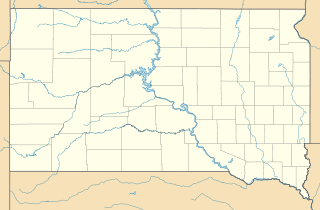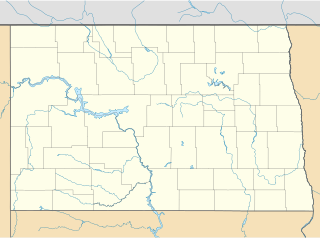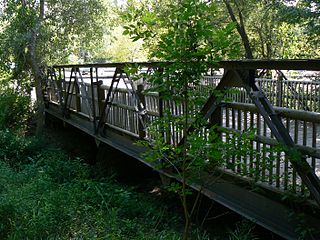
A covered bridge is a timber-truss bridge with a roof, decking, and siding, which in most covered bridges, create an almost complete enclosure. The purpose of the covering is to protect the wooden structural members from the weather. Uncovered wooden bridges typically have a lifespan of only 20 years because of the effects of rain and sun, but a covered bridge could last 100 years.

The Burr Arch Truss—or, simply, Burr Truss or Burr Arch—is a combination of an arch and a multiple kingpost truss design. It was invented in 1804 by Theodore Burr, patented on April 3, 1817, and used in bridges, usually covered bridges.
The Kansas City Bridge Company was a bridge building company that built many bridges throughout the Midwest United States in the early 1900s. The company was founded in 1893 and ceased business around 1960.

Buskirk Bridge is a wooden covered bridge and is the name of the hamlet in which it is located. It is in the town of Hoosick. The bridge, which crosses the Hoosic River is one of 29 historic covered bridges in New York State. The bridge takes its name from the nearby hamlet of the same name, which was named after the local Van Buskirk family.

Rexleigh Bridge is a wooden covered bridge over the Batten Kill in Washington County, New York. It is one of 29 historic covered bridges in New York State.

North Gypsum Creek Truss Leg Bedstead Bridge (59-LT-22) is an historic bridge in McPherson County, Roxbury, Kansas.

The Stamford Bridge, also known as Bridge No. 48-102-010, is a historic bridge in rural Mellette County, South Dakota, southeast of Stamford. Built in 1930, it is a three-span Bedstead Pony Truss bridge, carrying a local road over the White River, off County Road Ch 1. Each span measures 80 feet (24 m) in length, and the rest on two concrete piers and two concrete abutments with wing walls. The deck consists of steel I-beams, with wooden stringers topped by steel plates. The bridge is the longest Bedstead truss bridge in the state, and one of a modest number of surviving bridges built using this type of truss.

Midway Bridge near Johnstown, North Dakota is the only bedstead bridge known to have been built in North Dakota. It appears to have been built locally, not as part of a state or county program, during the 1920-1930 period. Also known as Bedstead Bridge, it is a Warren Bedstead-type truss bridge.

Canton Bridge Company was a firm that was later incorporated into the American Bridge Company. The firm was established in Canton, Ohio in 1892 and became one of the nation's biggest bridge-builders during the early 20th century. It designed and/or built many bridges that later became listed on the U.S. National Register of Historic Places (NRHP).

The Missouri Valley Bridge & Iron Co., also known as Missouri Valley Bridge Company, was a firm that built many bridges. It was based in Leavenworth, Kansas, with a WWII facility in Evansville, Indiana.

The Big Blue River Bridge near Surprise, Nebraska is a pin-connected Pratt truss bridge that was built in 1897. It was designed and built by the Canton Bridge Co. with steel fabricated by the Jones & Laughlin Steel Co.. Also denoted NEHBS No. BU00-84, it was listed on the National Register of Historic Places in 1992. It was deemed significant as a relatively rare example, and one of the oldest examples documented in Nebraska, of a truss leg bedstead bridge.

The Capon Lake Whipple Truss Bridge, formerly known as South Branch Bridge or Romney Bridge, is a historic Whipple truss bridge in Capon Lake, West Virginia. It is located off Carpers Pike and crosses the Cacapon River. The bridge formerly carried Capon Springs Road over the river, connecting Capon Springs and Capon Lake.

The Mynard Road Bridge, now located near Ashland, Nebraska, is a historic Warren truss leg bedstead bridge that was built in 1900. It was probably built by J.R. Sheeley and Company, of Lincoln, Nebraska and was listed on the National Register of Historic Places in 1992. The 50-foot (15 m) Mynard Road Bridge was the longest of its engineering type remaining in the state of Nebraska when the historic inventory was done in 1992, and was still used for vehicular traffic at that time. The bridge was originally situated on the Maynard Road and was built to span an unnamed stream, 4.7 mi (7.6 km) southeast of Louisville, Nebraska. In 2000, the bridge was relocated to be used as a pedestrian bridge at the Lee G. Simmons Conservation Park and Wildlife Safari.

The Grand River Bridge is a historic bridge located west of Leon, Iowa, United States. It spans the Grand River for 235 feet (72 m). A 7-panel Pratt Pony truss spans the main channel of the river, with a 4-panel Pratt pony truss/bedstead and timber stringer that forms the approach span on the west side. It was built by bridge contractors Daniel and Webster for $2,980 and completed in 1890. The bridge is no longer in use for vehicular traffic. It was listed on the National Register of Historic Places in 1998.

Marion County Bridge 0501F, also known as Indiana State Bridge 534-C-3439 on SR 100, is a historic truss bridge located on the Michigan Road at Indianapolis, Marion County, Indiana. It was built in 1941-1942, as a bridge along the State Road 100 project. It consists of two identical Warren pony truss sections at each end with two Parker through truss spans at the center. The pony truss sections are each 96 feet long and the through truss spans are 174 feet long.

The North Omaha Creek Bridge was a historic Pin-connected Pratt truss bedstead bridge that was built in 1905, located on 26 Road, a north–south rural road in Thurston County, Nebraska.

The Surprise Truss Bridge in Ten Mile, Tennessee was built in 1917. It was listed on the National Register of Historic Places in 1982.

The Ball Road-Little Salt Creek Bridge, also known as simply the Ball Road Bridge, was a bridge carrying Ball Road over Little Salt Creek in Jasper Township, Michigan. It was listed on the National Register of Historic Places in 1999. The bridge was later demolished.

















